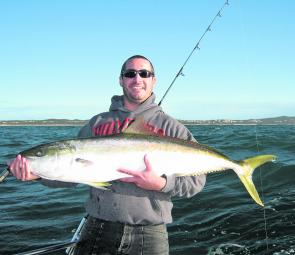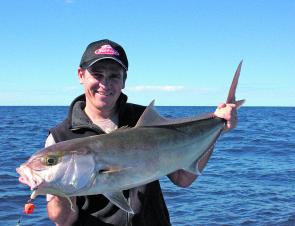Lately the weather has been atrocious and the fishing reports very few and far between. A lot of people give up on the game fishing over winter and go reef fishing instead.
Nevertheless, the best options for the hard core game fishers is blue marlin fishing on the shelf, where you are in with a chance of success 12 months of the year, and the middle grounds from 60-250m chasing a striper or late season black.
It would also be great to see someone crack daytime deep dropping for broadbill swordfish in South East Queensland, like they do overseas. Florida techniques were used by the Kiwis in their late summer/autumn season and they absolutely smashed it. It would be hard to know how many we have here on our local grounds due to the long liner numbers but the fleet is at an all-time low due to the high Aussie dollar, high diesel prices and natural attrition. Certainly on my estuary charters, bream fishing around the Mooloolah River trawler docks, the long liners seem to be unloading good quantities of broadies and tuna.
Your main options when broadbill fishing will be the daytime deep dropping techniques or night drifting or trolling. Everyone I have spoken to about night fishing out of here has said it is hard work. The winter land breeze makes things pretty choppy on the shelf and more people are prone to seasickness. If you can jag it, in my experience, you need a cloudy night to lock the heat in so you don’t get the temperature difference between sea and land, which causes the land breeze.
It is hard to pick at the best of times and some mornings you get out past about 12nm and you can actually get outside of the effect of it. Other times it is rougher the further out you go. Trolling a bit slower with luminescent lures or totally dark lures from the riggers and flat lines as per normal and a squid or lure on the downrigger is one tactic.
The other method is drifting with baits; most commonly squid set at different depths, either by balloon, sinker or downrigger. Game boats with gensets running with spotlights on are the go as the lights will attract the squid, which is the bait the broadies are eating and you should be trying to catch for bait. Circle hooks on 37kg breaking strain line are most commonly used as broadbill have the softest mouths of all the billfish species and many hooks are torn out during the fight.
Big broadies may require using 60kg line class tackle but the worry is pulling hooks under 20kg of drag, so on smaller ones you may need to really back the drag off. On small and average size fish you may need to use drag settings like you would use on 37kg line.
Daytime deep dropping is much harder to do while trying to still fish to IGFA rules. IGFA rated braid might be one way to go. You’ll have to make sure all of your big sinkers are breakaway; if it is deemed the big sinker was taking away some of the fighting ability of the fish it would not be an eligible capture. I am sure some rigs employ a braid reel or downrigger as a delivery system and then you can fight the fish on a normal IGFA mono rated line class outfit.
If you are out there just to do it or to catch one to eat you might as well go normal braid and even use one of your deep drop electric reels. Certainly a few deep droppers I have talked to have been hit on the wind up by big blues or broadies who start racing for the surface and the electric reels can’t keep up.
On braid, running really long mono leaders to act as big bungy cords in your system for the big lunges and head shakes may save you from pulling hooks in many instances. I have read in the literature the US guys using up to 30m of mono leader.
Expect to catch deep water ooglies, green eyed sharks and normal sharks while doing any of these methods. Mako sharks will be ok as they go hard and jump but the blue sharks and normal whalers will be like any boring shark fight.
The broadbill will fight many different ways. Some come up and tear around the surface like marlin then power dive back to the bottom, and others will just slug it out mid water.
The season ahead looks set to be another cracker with North Queensland already fishing well. Very often August and September are the best months for juvenile black marlin as they move south, so it is a good sign they are here early again. If you’re keen, you can start fishing for them at 1770 in September then Hervey Bay from October on. November they hit the Sunshine Coast but last season they missed the Sunshine Coast early and hit the Gold Coast in November, which was very early indeed. The week before Christmas is the traditional time the black marlin reach Gold Coast waters.
On charter I am now well and truly into reef fishing mode. The amberjack and yellowtail kingfish have been good when I have gone chasing them and these next few months will be the best for snapper fishing.
With the inshore 4.55m Seajay, bream have been the main catch. Catching a long liner or trawler unloading at the Mooloolah River trawler docks is a real bonus as the bream stack up where the brine or slurry is being pumped out. I had one good gar session before a big rain event flushed them out but as soon as it clears up, they will come back in the river. They are fun to catch, can be caught in big numbers when they are on, eat like whiting and make great bait frozen down for game fish and mackerel.
Give me a call at Smithys Fishing Charters on 0407 574 868 or check out my website, (www.smithysfishing.com.au ) to get out there and get into some fish!
Reads: 6998
Nathan on Smithys Fishing Charter holding up a ripper yellowtail kingfish he caught in close in 26m of water.

Damian with a decent amberjack. They have really been on the chew over winter.




